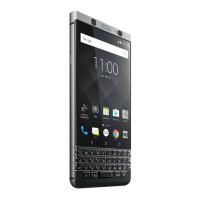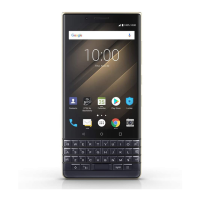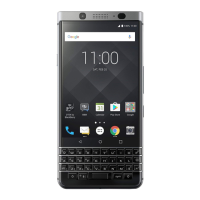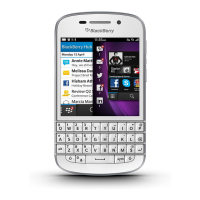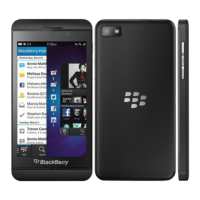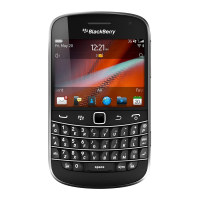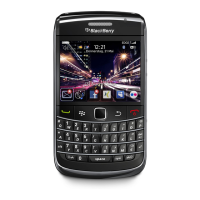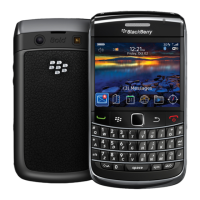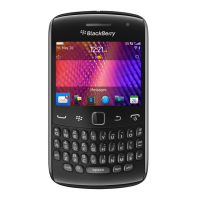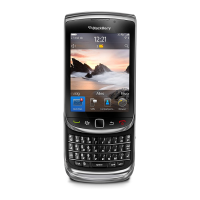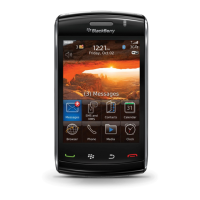Do you have a question about the Blackberry KEY2 and is the answer not in the manual?
Detailed steps for inserting the nano-SIM card into the device tray.
How to connect the charger and charge the device's battery.
Instructions for making calls, answering, and managing incoming calls.
Steps to block specific numbers or callers.
Guides on activating Voice over LTE and LTE video calling.
Steps to enable making and receiving calls over Wi-Fi networks.
Configuration steps for setting up voicemail services.
Instructions for downloading applications from the Google Play store.
How to send text and multimedia messages.
Guides on setting, customizing, and managing alarms.
Controls for location accuracy, modes, and history.
Controls for notification sounds, volume, and prioritization.
Managing cellular connections, airplane mode, and network types.
Connecting to Wi-Fi networks, manual setup, and proxies.
Turning on, pairing, and managing Bluetooth devices and profiles.
Checking data consumption by network type, app, or time period.
Establishing a limit for cellular data usage to prevent overages.
Viewing battery level and identifying apps consuming power.
Instructions for charging the device and understanding battery icons.
Adding, changing settings for, and deleting accounts.
Methods for backing up data, including Android Backup Service.
Setting up screen locks, PINs, patterns, and strong passwords.
Configuring device to stay unlocked in trusted situations.
Using Android Device Manager to find and secure lost or stolen devices.
Detailed steps for inserting the nano-SIM card into the device tray.
How to connect the charger and charge the device's battery.
Instructions for making calls, answering, and managing incoming calls.
Steps to block specific numbers or callers.
Guides on activating Voice over LTE and LTE video calling.
Steps to enable making and receiving calls over Wi-Fi networks.
Configuration steps for setting up voicemail services.
Instructions for downloading applications from the Google Play store.
How to send text and multimedia messages.
Guides on setting, customizing, and managing alarms.
Controls for location accuracy, modes, and history.
Controls for notification sounds, volume, and prioritization.
Managing cellular connections, airplane mode, and network types.
Connecting to Wi-Fi networks, manual setup, and proxies.
Turning on, pairing, and managing Bluetooth devices and profiles.
Checking data consumption by network type, app, or time period.
Establishing a limit for cellular data usage to prevent overages.
Viewing battery level and identifying apps consuming power.
Instructions for charging the device and understanding battery icons.
Adding, changing settings for, and deleting accounts.
Methods for backing up data, including Android Backup Service.
Setting up screen locks, PINs, patterns, and strong passwords.
Configuring device to stay unlocked in trusted situations.
Using Android Device Manager to find and secure lost or stolen devices.
| Screen shape | Flat |
|---|---|
| Display diagonal | 4.5 \ |
| Touch technology | Multi-touch |
| Touchscreen type | Capacitive |
| Display resolution | 1620 x 1080 pixels |
| Native aspect ratio | 3:2 |
| Processor cores | 4 |
| Processor family | Qualcomm Snapdragon |
| Processor frequency | 2.2 GHz |
| Coprocessor frequency | 1.8 GHz |
| RAM capacity | 6 GB |
| Compatible memory cards | MicroSD (TransFlash) |
| Maximum memory card size | 256 GB |
| Internal storage capacity | - GB |
| Flash type | LED |
| Rear camera type | Dual camera |
| Front camera type | Single camera |
| Maximum frame rate | 30 fps |
| Video recording modes | 1080p |
| Rear camera aperture number | 1.8 |
| Video capture resolution (max) | 3840 x 2160 pixels |
| Rear camera resolution (numeric) | 12 MP |
| Front camera resolution (numeric) | 8 MP |
| Second rear camera aperture number | 2.6 |
| Rear camera field of view (FOV) angle | 79.3 ° |
| Second rear camera field of view (FOV) angle | 50 ° |
| 4G standard | LTE-TDD |
| 2G standards | EDGE, GPRS, GSM |
| 3G standards | HSPA+ |
| Wi-Fi standards | 802.11a, Wi-Fi 5 (802.11ac), 802.11b, 802.11g, Wi-Fi 4 (802.11n) |
| Bluetooth version | 5.0 |
| 3G bands supported | 850, 900, 1700, 1900, 2100 MHz |
| 4G bands supported | 700, 800, 850, 900, 1700, 1800, 1900, 2100, 2600 MHz |
| SIM card capability | - |
| 2G bands (secondary SIM) | 850, 900, 1800, 1900 MHz |
| Mobile network generation | 4G |
| Subscription type | No subscription |
| USB version | 3.2 Gen 1 (3.1 Gen 1) |
| USB connector type | USB Type-C |
| Headphone connectivity | 3.5 mm |
| Multimedia Messaging Service (MMS) | Multimedia Messaging Service (MMS) is a standard way to send messages that include multimedia content to and from a mobile phone over a cellular network |
| Form factor | Bar |
| Product color | Black |
| Themes | Wallpapers |
| Personalization | Icons, Menu, Shortcuts |
| Personal info management (PIM) | Alarm clock, Calculator, Calendar, Events reminder, Notes, To-do list |
| Audio formats supported | FLAC, MID, MP3, OGG, RTTTL, RTX, WAV, XMF |
| Image formats supported | BMP, GIF, JPG, PNG, WEBP |
| Video formats supported | 3G2, AVI, DIVX, MKV, MPEG4, WEBM |
| Video compression formats | H.263, H.264 |
| Platform | Android |
| Google applications | Google Maps, Google Play, YouTube |
| App distribution platform | Google Play |
| Operating system installed | Android 8.1 |
| Talk time (3G) | - h |
| Battery capacity | 3500 mAh |
| Cables included | USB |
| Depth | 8.5 mm |
|---|---|
| Width | 71.8 mm |
| Height | 151.4 mm |
| Weight | 168 g |
